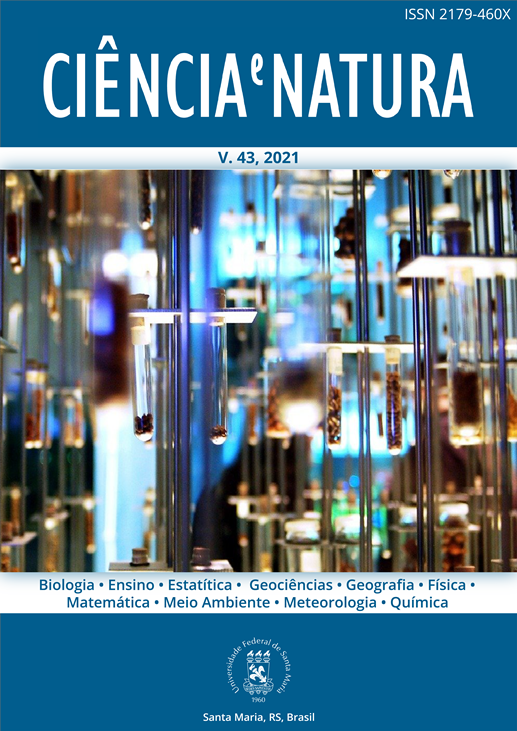MHS e MCU: a conexão desses movimentos no ensino de física
DOI:
https://doi.org/10.5902/2179460X64852Palavras-chave:
Movimento Harmônico, Movimento Circular, Ensino de Física.Resumo
O presente trabalho é o resultado de um esforço conjunto realizado entre alunos da disciplina Oscilações e Ondas do curso de licenciatura em física do Instituto Federal de São Paulo. Diante das inúmeras equações diferenciais inerentes ao estudo do movimento oscilatório, surgiu a questão: como abordar esse tema no ensino médio? A dificuldade reside no fato de que o aluno nessa etapa de ensino não tem como compreender equações diferenciais. Sendo assim, foi desenvolvido uma proposta de abordagem para o ensino do Movimento Harmônico Simples (MHS), a partir da relação desse movimento com o Movimento Circular Uniforme (MCU). Além disso, propõe-se uma demonstração para as equações dos períodos desse tipo de movimento. Com o intuito de trazer ao aluno uma experiência mais concreta acerca do tema, dois experimentos com material de baixo custo foram propostos e executados pelos autores.Downloads
Referências
Eves, H. W. (1995). Introdução à história da matemática. Unicamp.
Ferreira, A. L., Borrero, P. P. G. (2005). Uma proposta para o ensino de oscilações. RECEN-Revista Ciências Exatas e Naturais, 7(2), 155–171.
Ferreira, D. B., Villani, A. (2002). Uma reflexão sobre prática e ações na formação de professores para o ensino de física. Revista Brasileira de Pesquisa em Educação em Ciências, 2.
Feynman, R. P., Leighton, R. B., Sands, M. (2008). Lições de Física–Vol. 1. Bookman.
Hewitt, P. G. (2007). Fundamentos de física conceitual, 9o
edn. Bookman.
Neto, A. P. S., dos Santos, A. B. (2015). Atividade para ensino de oscilações e ondas no ensino fundamental.
Neves, M. C. D. (1998). A história da ciência no ensino de física. Ciência & Educação (Bauru), 5(1), 73–81.
Nussenzveig, H. M. (2002). Curso de Física Básica: fluidos, oscilações e ondas, calor, 4oedn. Editora Blucher.
Pinheiro, D. M., Murakami, G. E., Beraldo, N., Witkowski, F. M., Brunelli, D. D., Germano, J. S. E. (2013). Uso do software de
simulação interactive physics como ferramenta de apoio ao professor em sala de aula no ensino de oscilações mecânicas. Em:CONGRESSO BRASILEIRO DE EDUCAÇÃO EM ENGENHARIA.
Pinto, S., Silva, L., Tenório-de Carvalho, C., Egoavil, C. (2004). Pêndulo simples utilizando tecnologia embarcada de baixo custo
aplicado ao ensino da física. Lat Am J Sci Educ, 2015, 2–6.
ROONEY, A. (2013). A História da Física: da Filosofia ao Enigma da Matéria Negra, 1o edn. São Paulo-M. Books do Brasil
Editora Ltda.
Young, H. D., Freedman, R. A. (2015). Física, II: Termodinâmica e ondas, 14oedn. Bookman
Publicado
Como Citar
Edição
Seção
Licença
Para acessar a DECLARAÇÃO DE ORIGINALIDADE E EXCLUSIVIDADE E CESSÃO DE DIREITOS AUTORAIS clique aqui.
Diretrizes Éticas para Publicação de Revistas
A revista Ciência e Natura está empenhada em garantir a ética na publicação e na qualidade dos artigos.
A conformidade com padrões de comportamento ético é, portanto, esperada de todas as partes envolvidas: Autores, Editores e Revisores.
Em particular,
Autores: Os Autores devem apresentar uma discussão objetiva sobre a importância do trabalho de pesquisa, bem como detalhes e referências suficientes para permitir que outros reproduzam as experiências. Declarações fraudulentas ou intencionalmente incorretas constituem comportamento antiético e são inaceitáveis. Artigos de Revisão também devem ser objetivos, abrangentes e relatos precisos do estado da arte. Os Autores devem assegurar que seu trabalho é uma obra totalmente original, e se o trabalho e / ou palavras de outros têm sido utilizadas, isso tem sido devidamente reconhecido. O plágio em todas as suas formas constitui um comportamento publicitário não ético e é inaceitável. Submeter o mesmo manuscrito a mais de um jornal simultaneamente constitui um comportamento publicitário não ético e é inaceitável. Os Autores não devem submeter artigos que descrevam essencialmente a mesma pesquisa a mais de uma revista. O Autor correspondente deve garantir que haja um consenso total de todos os Co-autores na aprovação da versão final do artigo e sua submissão para publicação.
Editores: Os Editores devem avaliar manuscritos exclusivamente com base no seu mérito acadêmico. Um Editor não deve usar informações não publicadas na própria pesquisa do Editor sem o consentimento expresso por escrito do Autor. Os Editores devem tomar medidas de resposta razoável quando tiverem sido apresentadas queixas éticas relativas a um manuscrito submetido ou publicado.
Revisores: Todos os manuscritos recebidos para revisão devem ser tratados como documentos confidenciais. As informações ou ideias privilegiadas obtidas através da análise por pares devem ser mantidas confidenciais e não utilizadas para vantagens pessoais. As revisões devem ser conduzidas objetivamente e as observações devem ser formuladas claramente com argumentos de apoio, de modo que os Autores possam usá-los para melhorar o artigo. Qualquer Revisor selecionado que se sinta desqualificado para rever a pesquisa relatada em um manuscrito ou sabe que sua rápida revisão será impossível deve notificar o Editor e desculpar-se do processo de revisão. Os Revisores não devem considerar manuscritos nos quais tenham conflitos de interesse resultantes de relacionamentos ou conexões competitivas, colaborativas ou outras conexões com qualquer dos autores, empresas ou instituições conectadas aos documentos.






